

Binocular Reviews Home > Binoculars by Use > Best Horse Racing Binoculars
>> Skip the blurb, show me the best horse racing binoculars
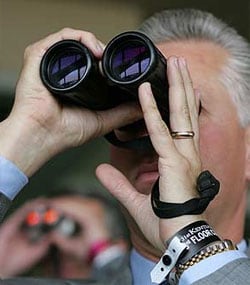 No matter if you are going to the Kentucky Derby, the Grand National or just you local meet you really should not leave home without a good pair of horse racing binoculars as they will most definitely improve your enjoyment of the event. But what exactly makes a good pair or binoculars for horse racing?
No matter if you are going to the Kentucky Derby, the Grand National or just you local meet you really should not leave home without a good pair of horse racing binoculars as they will most definitely improve your enjoyment of the event. But what exactly makes a good pair or binoculars for horse racing?
When choosing any pair of optics for a specific purpose, you first need to decide what the most important features are for their main intended use, then you can look for a pair of optics that match all or as many of these features as possible.
A pair of really good racing binoculars will actually be very similar to that of a really good general sporting event binocular and indeed a good bird watching binocular, but with a few subtle differences:
I think the first thing you need to consider when deciding on a horse racing binocular is what size you want. Always keeping in mind that you will have to carry it about with you to and from and whilst you are at the races. But compacts do have their drawbacks and so some people may feel that the benefits that full size or even mid-sized binoculars have over them are worth the extra weight and size.
Obviously a small pair will be very portable with some bins small enough to pop into your jacket pocket, but as you will see below, different sized binoculars have their own particular advantages and disadvantages and the choice you make may not be quite as simple as how easy they are to carry.
Personally I like to take a really compact pair of binoculars with me to the races, but compacts do have their drawbacks and so some people may feel that the benefits that full size or even mid-sized binoculars have over them are worth the extra weight and size.
There two main advantages that larger binoculars have over compacts in relation to horse racing are:
If you want a better performance than a compact can offer, but don't want to carry about a full sized pair of optics, you should consider a pair of mid size binoculars which are a great compromise between the two.
Tip: When it comes to size, not all compact binoculars are created equal. So if you really want a small pair that you can just pop away in your pocket when not in use, look out for roof prism compacts that have a duel hinge design that makes them far smaller than standard single hinge or porro prism compacts when folded. For more details take a look at my article on the Best Compact Pocket Binoculars.
Closely related to size, is the designs/styles of binocular. In general, you will come across two main designs/styles of binocular depending on the type of prism they use: the Roof Prism or the Porro Prism. Both have their own unique advantages over each other and so as with many things in optics there is no best option or right answer and the choice you make will be down to your own personal preferences:
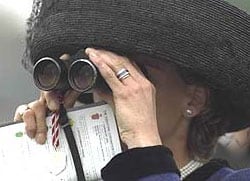 Roof Prism Advantages: The compact prism design usually means a smaller more compact binocular than porro prisms with the same size objective lenses. There are also less moving internal parts, so tend to be tougher and longer lasting.
Roof Prism Advantages: The compact prism design usually means a smaller more compact binocular than porro prisms with the same size objective lenses. There are also less moving internal parts, so tend to be tougher and longer lasting. 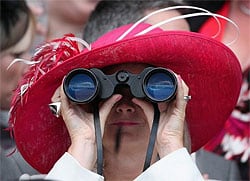 Porro Prism Advantages: Because the objective lenses are wider apart, they tend to have a better stereoscopic image and a wider field of view than porro prisms. They are also cheaper to make than roof prisms and so tend to be optically superior in the cheap to mid price ranges.
Porro Prism Advantages: Because the objective lenses are wider apart, they tend to have a better stereoscopic image and a wider field of view than porro prisms. They are also cheaper to make than roof prisms and so tend to be optically superior in the cheap to mid price ranges.The whole point of a taking a pair of binoculars to the races is to get closer to the action, so you may be forgiven for thinking that the more powerful the magnification the better. This is not true as high powered binoculars have a two main drawbacks that will make viewing the races far from ideal:
So you have to make a compromise between getting close enough to the action to really see what is going on, but not so close that it makes actually seeing what is going on difficult! So in my opinion binoculars with a magnification between 7x and 10x will be more than adequate for most horse race events. If however you are going to be particularly far away from the action you could consider a 12x magnification which is still fairly easy to keep still, but will get you just that bit closer to the action.
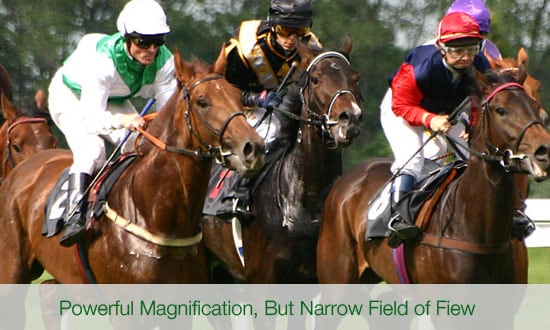
The field of view (FOV) of a pair of binoculars is basically the width of the image that you can see through the binoculars and so a wide FOV enables you to catch as much of the action all at once without having to move the binoculars about. In horse racing, the distances that you view the action tends to be fairly big and the main group of horses tend to keep fairly close together and so the FOV is perhaps not as important as in many other sports. But ideally you still want is a pair of binoculars with as wide a field of view as possible in your chosen magnification, enabling you to observe as much of the action without having to move the binoculars all around the place.
The FOV is usually expressed in feet at a distance of 1,000 yards, but increasingly common is in meters at 1,000 meters or it is sometimes described as an angle. I would say that a FOV of 315ft at 1,000 yards (105m at 1,000 meters / 6.0° ) should be fine, but as I say, the wider the better, so if you are undecided between two models, check which has the widest FOV.
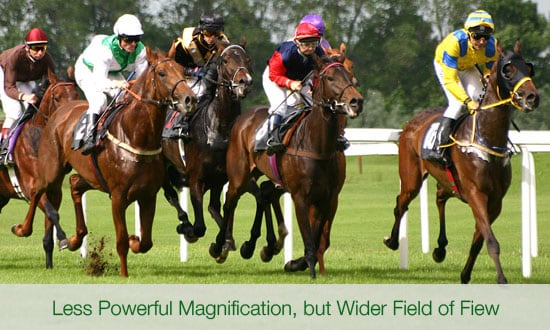
This is only really important if you use eye glasses. Basically Eye Relief is the distance from the ocular lenses where you will see the full field of view. The eyecups on binoculars ensure that your eyes are positioned at the correct distance from the ocular lens, but if you wear glasses and want to keep them on whilst glassing, you need to reduce this distance to ensure that you still see the entire view without any vignetting on the sides.
Adjustable eyecups allow you to change the distance and ensure that even with your glasses on your eyes are the correct distance from the ocular lenses. Binoculars with a longer eye relief are ideal for those who wear glasses as they basically project the image further beyond the ocular lens, giving you plenty of room to play with. So if you wear glasses, you should be looking for an eye relief of at least 15mm, to see the full image full image.
The down side to long eye relief is that it usually reduces the field of view. Some people wonder if you need to wear glasses at all using binoculars, well If you are near-sighted or far-sighted, you can use your binoculars without wearing glasses and the binoculars focus will compensate, but if you have astigmatism, you will need to use your glasses.
Below you will see that I have listed a few of the best horse racing binoculars that I have reviewed in the three main size categories:
Or you can take a look at All Binoculars ideal for Sporting Events, including Horse Racing that I have so far reviewed.
|
Updated with a fully multi-coated optical system the Pentax Papilio II is now better & more versatile than ever. With their incredibly close minimum focusing distance these are ideal for the close observation of things like butterflies or flowers when out in the field or for use in a gallery or museum. Other optical highlights include quality BaK4 reverse Porro prisms and aspherical lens elements for a quality and brightness of view that is impressive for a compact binocular at this price level. Price: (2/6) Low Cost Binoculars | |||||||||||||||
|
|
A compact binocular that the Transformers would be proud of! The Pentax VD 4x20 can be split in half and thus converted into two 4x monoculars, which in turn can be placed end-on-end, transforming it once again into a mini-sized, but powerful 16x Spotting Scope! Price: (3/6) Mid Priced Binoculars | |||||||||||||||
|
|
Available in 7 different bright colors, these low cost Levenhuk Rainbow binoculars also feature a very compact double hinge design, fully water and fog proof shell, BaK-4 roof prisms, twist-up eye-cups and multi-coated optics. Add to this a very wide field of view, then these and their other features combine to make a compact ideal for general use, travel, hiking and especially for viewing outdoor sports like horse racing, tennis or cricket, where I can see their colors really making them stand out from the crowd. They also make great kids binoculars. Price: (2/6) Low Cost Binoculars | |||||||||||||||
|
|
Small, lightweight, and versatile monocular when combined with the complete kit easily converts into an 18x microscope. Highlights include an extremely wide field of view, very close minimum focus distance, plenty of eye relief, and a unique shape and rocker focus mechanism making it both comfortable and very easy to use in just one hand. Price: (3/6) Mid Priced Monocular | |||||||||||||||
|
|
Low costing compact binocular from Levenhuk that comes with a number of higher end features including a water and fog proof shell that protects fully multi-coated optics within. Highlights also include a very wide field of view and a close minimum focusing distance. Price: (2/6) Low Cost Binoculars | |||||||||||||||
|
Below are some of the best Mid Size binoculars for horse racing, sorted by size, that I have so far reviewed:
|
Mid-sized, mid-priced Hawke binoculars that impress in almost single every area. A fully fog and waterproof magnesium housing protects high quality and fully multi-coated optics with highlights that include ED glass lenses, BaK-4 roof prisms that have been phase corrected. The result is a high quality and bright image that has a wide field of view, good close focus and delivers plenty of eye-relief. Price: (3/6) Mid Priced Binoculars | |||||||||||||||
|
|
Weighing just 17.6oz ounces and measuring 4.7 inches long by 4.5 inches wide, it's hard to believe Swarovski can pack so much of their renowned optical excellence into such a compact unit and make it just that bit more affordable, but they have. Ideal for anyone looking for a premium compact binocular to take travelling, on safari, hiking, camping or to a sporting event, the CL Companion includes their legendary Swarotop & Swarodur anti-reflection coatings as well as phase correction and Swarobright coatings on the roof prisms producing an excellent high quality image even in low light situations. Price: (5/6) High Value Binoculars | |||||||||||||||
|
|
Comfortable, easy to carry about and with a bright, good quality image, I love using these Opticron Savanna WP 6x30 binoculars, which I think this will also be the case for many people looking for an inexpensive, easy to use binocular as I feel they offer a good compromise between size, weight and image quality, and brightness. Highlights include an excellent price to performance ratio, a wide field of view, steady 6x magnified image and a huge amount of eye-relief. Price: (2/6) Low Cost Binoculars | |||||||||||||||
|
Below are some of the best Full Size binoculars for horse racing, sorted by size, that I have so far reviewed:
|
The Zeiss 8x42 T* binoculars are close to binocular perfection and make ideal binoculars for everything from birding and outdoor recreation to virtually any sightseeing venture.
Price: (6/6) Expensive Binoculars |
|
With an amazing 10x magnification and all the quality that you come to expect with Carl Zeiss Binoculars, the Zeiss Victory FL 10x42 T* binoculars make superb birdwatching binoculars and could be as close to the perfect Safari and Wildlife viewing binoculars as you could ever hope to get.
Price: (6/6) Expensive Binoculars |
|
Designed to compete with the very best this Kowa Genesis XD44 binocular utilizes optical technology taken from their popular range of TSN Spotting Scopes including the excellent Prominar XD lens to make a binocular that produces images of the highest quality. Combined with a tough waterproof body, these make excellent binoculars for nature viewing, outdoor sports and general use.
Price: (6/6) Expensive Binoculars | |||||||||||||||
| |||||||||||||||
|
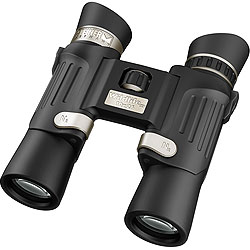 Related Articles & Further Reading
Related Articles & Further Reading